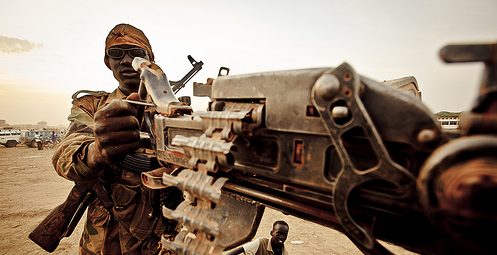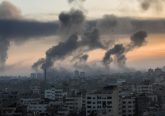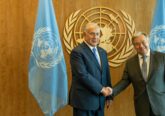Conflict researchers tend to dichotomise the parties involved in armed conflicts. While this dyadic perspective provides a useful simplification for the purpose of ordering the inherently unordered, it also leads to misperceptions and misrepresentations of the dynamics on the ground. Just as interstate conflicts are not necessarily fought between only two countries, intrastate conflict is rarely solely an affair of just governments and a rebel group. Omissions of other belligerents are particularly problematic if the neglected actors are systematically more prone to violent actions, or if they exert disproportionate impacts on the trajectories of conflicts and their aftermaths. Against this backdrop, our research, forthcoming in the Journal of Peace Research, highlights the specific impact of pro-government militias on the risk of conflict recurrence. Our empirical analysis demonstrates that armed conflicts in which pro-government militias have been active are more likely to relapse.
Pro-government militias are armed groups that have a link to the government in power but operate outside of the regular security apparatus.[1] Oftentimes, they receive weapons from the government or they share information and logistics in the fight against a common enemy. Pro-government militias have been involved in various armed conflicts around the world. For instance, the ‘Janjaweed’ militia played a significant role in the genocide in Dafur and the ‘Interahamwe’ militia was a key player in the Rwandan genocide. The ‘Arkan’s tigers’ militia that was responsible for some of the most egregious human rights violations in the Yugoslavian civil war, the infamous ‘Ninjas’ militia was active in pre-independence East Timor, and, more recently, the ‘Aidar battallion’ has become an important force on the Ukrainian side in the ongoing confrontation with Russia. Indeed, pro-government militia involvement has been the rule rather than the exception in recent armed conflicts. Sabine Carey and colleagues found that governments collaborated with militia groups in over 80% of the country-years of armed conflict between 1981 and 2007.[2]
Militias undoubtedly represent an erosion of the Weberian ‘monopoly of violence’. Yet, research pioneered by Neil Mitchell (University College London) and Sabine Carey (University of Mannheim) recognizes the advantages and strategic incentives for states in delegating violence to militia groups. Relying on militia groups allows governments to outsource accountability for repressive actions, to gain access to local knowledge, and to cheaply increase their forces.[3] Instead of just being symptomatic for state decay, pro-government militias are regarded as a powerful instrument at the disposal of states conducting counterinsurgency campaigns. While outsourcing violence to militia groups offers strategic benefits to governments, evading accountability is especially important for states dependent on foreign aid,[4] there are also high costs, in particular for civilians; conflicts with pro-government militia involvement have been found to have higher prevalence of human rights violations.[5]
Despite the ubiquity of pro-government militias, little is known about the consequences of their presence and activities once armed conflicts have come to an end. Understanding the long-term impact of these groups on post-conflict environments is crucial. Characterised as ‘conflict trap’ by Paul Collier and his colleagues prior conflicts have shown to be the strongest predictors of further conflicts.[6]While there is substantial research trying to understand the reoccurrence of conflict,[7]the role and contribution of pro-government militia involvement in relapses of fighting has been overlooked. Motivated by this gap in the literature, we set out to study how the involvement of pro-government militias in prior armed conflicts affects the stability of post-conflict peace.
We first investigated why militiamen might have an interest in resumed fighting, by scrutinizing how armed conflicts shape militiamen’s self-interests and their incentive structure in post-conflict contexts. Pro-government militias’ privileged position as government agents outside of the state’s official control mechanisms allows fighters to exploit the conflict environment to further their material goals. We find substantial evidence for looting and criminal self-enrichment of militiamen in armed conflicts around the world. For instance, the fighters of the Arkan’s Tigers militia have been characterised as “having the times of their lives in the mountains of Bosnia [being] no longer in any mood to return to the dull, pre-war stupefaction of factory jobs and unemployment”.[8] Anecdotal evidence from pro-government militias around the world also illustrates the difficulty of former fighters in reintegrating to civilian life and the costs of leaving the network of the militia group. The interplay of these dynamics suggests that militiamen’s preferences are tilted towards renewed conflict outbreak.
Once we established that militia fighters often have an interest in conflict recurrence, we identified three channels through which pro-government militias have an impact on conflict recurrence.
- Pro-government militias are commonly absent from peace negotiations which take place exclusively between governments and rebels. This omission is problematic as previous research demonstrated that peace agreements must include all conflict parties to deliver sustainable peace.[9]Even if there are intentions to include militia groups, their obscure command structures and hierarchies may thwart the identification of credible group representatives and hinder the formulation of unambiguous demands. Consequently, we posit that pro-government militias are particularly likely to become ‘outside spoilers’ of peace agreements.[10]
- Pro-government militias are less likely to be successfully disarmed after conflicts than regular armies or rebel groups. Evidence from Afghanistan and Libya suggests that disarmament, demobilisation, and reintegration (DDR) programs failed to address informal actors such as militia groups. Even if pro-government militias are explicitly targeted, such efforts are likely to be ineffective without substantial resources available for disarmament and compensation.
- Pro-government militias enjoy a government bonus which lowers their inhibition to reignite fighting. Due to their instrumental value for governments engaged in counterinsurgency campaigns, they are more inclined to turn a blind eye on militiamen’s conduct. Anecdotal evidence from militias such as the Janjaweed militia in Sudan suggests far-reaching impunity.
We find strong empirical support for the hypothesis that pro-government militia involvement in armed conflicts increases the risk of conflict relapse analysing armed conflicts between 1981 and 2007. We coded whether pro-government militias were involved in counterinsurgency campaigns and whether the same groups were active in recurred conflict episodes. By comparing such conflicts with conflicts without pro-government militia involvement, our propensity scores matched simulations, suggesting that conflicts with pro-government militia involvement are about 20% more likely to recur.
Our findings call for enhanced emphasis on pro-government militia groups in peacebuilding efforts. In order to reach sustainable peace after armed conflicts, it is essential to account for pro-government militia’s specific interests in peace negotiations and to provide sufficient resources for a comprehensive disarmament and reintegration of all conflict parties. Most notably, peacebuilding efforts by the international community must overcome dichotomised thinking and acknowledge the multitude and complexity of actors involved in armed conflicts.
The research this blog post is based one has been conducted by Christoph Steinert at the Department of Politics and International Relations (Oxford) in collaboration with Janina Steinert from the Department of Social Policy and Intervention (Oxford) and with Professor Sabine Carey from the University of Mannheim.
[1] Carey, Sabine C., Neil J. Mitchell and Will Lowe. 2013. ‘States, the Security Sector, and the Monopoly of Violence: A New Database on Pro-Government Militias.’ Journal of Peace Research 50(2): 249-258.
[2] Carey, Sabine C. & Neil J. Mitchell. 2016. ‘Pro-Government Militias and Conflict’. Oxford Research Encyclopedia of Politics.
[3] E.g.: Carey, Sabine C., Michael P. Colaresi, and Neil J. Mitchell. 2015. ‘Governments, Informal Links to Militias, and Accountability’. Journal of Conflict Resolution. 59(5): 850-876.
[5] Neil J. Mitchell, Sabine C. Carey and Christopher Butler. 2014. ‘The Impact of Pro-Government Militias on Human Rights Violations’. International Interactions. 40(5): 812-836.
[6] Collier, Paul. Breaking the conflict trap: Civil war and development policy. World Bank Publications, 2003.
[7] E.g. Quinn, J. Michael, T. David Mason, and Mehmet Gurses. 2007. ‘Sustaining the peace: Determinants of civil war recurrence.’ International Interactions 33.2: 167-193; Collier, Paul & Anke Hoeffler. 2004. ‘Greed and Grievance in Civil War.’ Oxford Economic Papers 56(4): 563-95; Collier, Paul & Anke Hoeffler. 2006. ‘Military expenditure in post-conflict societies.’ Economics of Governance 7(1): 89–107; Hegre, Håvard. “Toward a democratic civil peace? Democracy, political change, and civil war, 1816–1992.” American political science review 95.1 (2001): 33-48.
[8] Traynor, Ian. 1992. Dead Arkan leads decent inferno. The Guardian, 29 May (http://www.sowi.uni-mannheim.de/militias-public/data/pgag/360/evidence/).
[9] Nilsson, Desirée. 2008. Partial peace: Rebel groups inside and outside of civil war settlements. Journal of Peace Research 45(4): 479-495.
[10] Stedman, Stephen. 1997. Spoiler problems in peace processes. International Security 22(2): 5-53.







